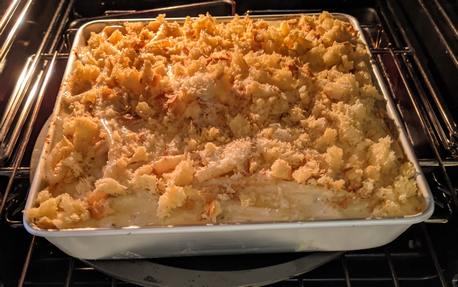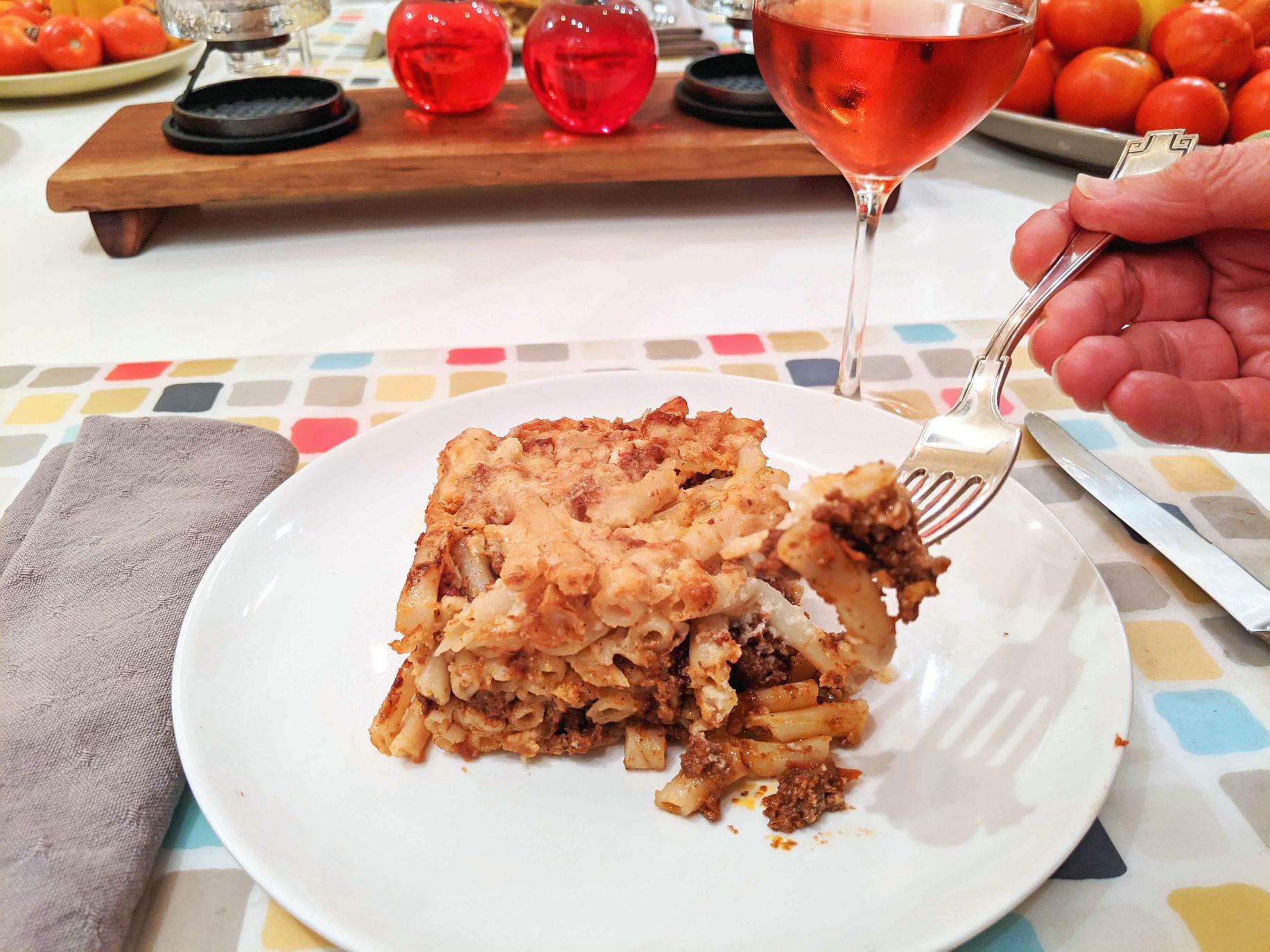Our nearly four-month exploration of Greek cuisine has netted us some dishes that we expect to stay in the rotation for years to come. Most rely on the goodness of fresh local produce, so we thought the arrival of autumn was an auspicious time to conclude our research. Frost is on the way, and outdoor grilling gets harder and harder as the temperature drops and darkness falls earlier and earlier.
We decided that the best cool-weather Greek dish for us to perfect would not be any of the many variations of Greek lamb stews, but instead the dish sometimes called ‶Greek lasagna.″ A baked casserole, pastitsio contains layers of tubular noodles, a meat sauce, and a cheese-laden béchamel. While the tomatoes in the meat sauce have to be a post-1600 addition, there’s evidence that the Greeks were eating baked pasta dishes so far back in antiquity that the Italians hadn’t even gotten organized.
Spicing sets the meat sauce in pastitsio apart from its Italian cousins. The dominant spice is cinnamon, which was highly prized in Greek cuisine at least since the 8th century bce. We’ve added some other warm spices. Frankly, it reminds us of Cincinnati chili sauce—which was created by Greek immigrants. If you want to feed a crowd (preferably in the post-COVID era), double the recipe and use a 11×17 pan. It’s just the thing for a cold winter night.
PASTITSIO
 INGREDIENTS
INGREDIENTS
for meat sauce
1 tablespoon olive oil
1 medium onion, finely chopped
pinch salt
2 large garlic cloves, minced
2 pounds ground lamb (or beef, for non-lamb eaters)
3 cups of ground peeled tomatoes
2 thyme sprigs
1 teaspoon ground cinnamon
1 teaspoon ground allspice
1/4 teaspoon ground nutmeg
pinch of ground cloves
for béchamel
4 tablespoons butter
4 tablespoons all-purpose flour
3 cups whole milk
1/2 teaspoon nutmeg
1/2 cup grated Parmigiano-Reggiano cheese
1 1/2 teaspoons salt
3 large egg yolks
for pasta
1 lb. package regine, bucatini, or pastitsio noodles
1 cup coarse fresh bread crumbs
2 tablespoons grated Parmigiano-Reggiano cheese
DIRECTIONS
Make the meat sauce one day ahead. Add a little olive oil to a deep 10-inch diameter frying pan and heat over medium. Add chopped onion, sprinkle with pinch of salt, and cook until onions are just translucent. Add the garlic and cook one minute. Add ground meat and cook until it loses all redness. Be sure to break up lumps. Stir in tomatoes, thyme, and spices. Simmer at least 40 minutes, stirring occasionally to keep from burning. Ideally, let cool and refrigerate overnight.
Make the béchamel. Melt butter in a heavy medium pot over medium heat. Whisk in flour, then cook roux, whisking frequently, until pale golden, about 6 minutes.
Meanwhile, heat milk in a heavy saucepan to a low simmer. Add milk to roux in a stream, whisking constantly until very smooth. Whisking all the time, bring to a boil over medium heat, then cook 1 minute. Remove from heat and stir in nutmeg, cheese, and salt.
Lightly beat yolks in a bowl. Gradually whisk in 1 cup béchamel, then whisk yolk mixture into remaining béchamel in saucepan.
Assemble the pastitsio.
Set oven to 375°F with rack in middle and bring meat sauce to room temperature..
Cook noodles in boiling salted water until al dente. Drain. When cool, place in large bowl and mix in 1/2 cup béchamel.
Arrange a third of the pasta in a single layer in a 10-inch square baking pan. Add half of meat sauce (about 1 1/2 cups) to baking pan, spreading evenly over pasta. Make another layer of pasta and top with remaining meat sauce, then arrange remaining pasta on top. Spread remaining béchamel (about 2 1/2 cups) evenly over top layer of pasta.
Stir together bread crumbs and cheese and sprinkle evenly over top of pastitsio. Bake until crumbs are golden brown and sauce is bubbling, about 45 minutes.

